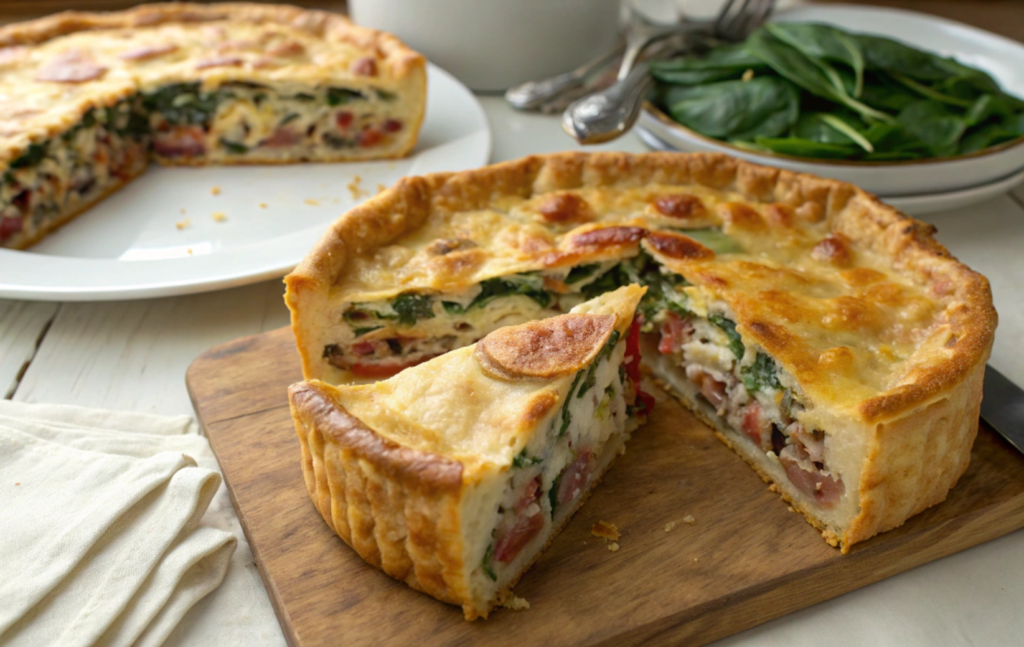If you’ve ever dreamed of recreating a dish that feels like a warm hug from Italy, pizza rustica is the answer. This savory pie is a staple during Easter celebrations in Italian households; however, its indulgent flavors and rich textures make it a dish worth enjoying year-round. This guide will teach you everything you need to know about making pizza rustica, from its history to the perfect techniques for preparing this layered masterpiece.
Whether cooking for family, entertaining guests, or exploring new culinary traditions, this recipe will serve as your gateway to Italian comfort food at its finest.
What Is Pizza Rustica?
A Traditional Italian Easter Pie
Pizza Rustica, also known as Italian Easter pie, is a cherished dish deeply rooted in Southern Italian traditions, particularly in Naples. It’s a savory, multi-layered pie made with a flaky pastry crust and filled with a rich blend of cheeses, cured meats, and eggs. Traditionally prepared for Easter, pizza rustica symbolizes abundance and the end of Lenten fasting, bringing indulgent flavors back to the table. Each bite is a harmonious balance of creamy, salty, and savory elements. Over the years, families have added their regional twists, making this dish as versatile as it is deliciously timeless.
What Makes Pizza Rustica Unique?
- Flaky Crust: The crust of pizza rustica sets it apart from other savory pies. It is buttery, tender, and slightly sweet, perfectly complementing the rich filling inside. The delicate layers, achieved by using chilled butter and careful preparation, make each bite a textural delight.
- Savory Filling: The filling is a luxurious blend of creamy ricotta, shredded mozzarella, and grated pecorino cheeses, paired with salty cured meats like salami and prosciutto. This combination creates a harmonious balance of flavors—savory, creamy, and indulgent.
- Tradition Meets Creativity: Rooted in Italian Easter traditions, pizza rustica also invites creativity. Each region—and family—brings its twist, adding ingredients like roasted vegetables, unique spices, or decorative crust designs, making every pie a personal masterpiece.
Ingredients for the Perfect Pizza Rustica
Creating the perfect pizza rustica starts with high-quality ingredients. Without these, the dish would lack the authentic Italian flair that makes it so special. Here’s a comprehensive list to guide your shopping:
The Dough
The crust is the foundation of this dish, and its buttery, flaky texture is key.
- All-purpose flour (3 cups)
- Unsalted butter (1 cup, chilled and cubed)
- Eggs (2, for binding)
- Sugar (2 tablespoons)
- Salt (1 teaspoon)
- Ice-cold water (as needed)
The Filling
This is where the magic happens. The combination of cheeses, meats, and spices creates a deeply satisfying experience. Moreover, it offers room for personal customization.
- Ricotta cheese (2 cups)
- Mozzarella cheese (1 cup, shredded)
- Pecorino Romano (½ cup, grated)
- Salami (1 cup, cubed)
- Prosciutto (½ cup, sliced)
- Eggs (3, beaten)
- Fresh parsley (2 tablespoons, chopped)
- Black pepper (1 teaspoon)
Ingredients Table
| Ingredient | Quantity | Notes |
|---|---|---|
| All-purpose flour | 3 cups | For the dough |
| Unsalted butter | 1 cup | Chilled, cut into small cubes |
| Ricotta cheese | 2 cups | Whole-milk preferred |
| Mozzarella cheese | 1 cup | Shredded |
| Salami | 1 cup | Cubed or sliced |
| Eggs | 5 large | 3 for filling, 2 for dough |
Step-by-Step Instructions to Make Pizza Rustica
Preparing the Dough
The crust is the first step, and it sets the tone for the dish. Therefore, taking your time with this step is crucial.
- To begin, combine flour, sugar, and salt in a large mixing bowl.
- Next, add chilled butter cubes and work them into the flour using a pastry cutter or your fingers until the mixture resembles coarse crumbs.
- Afterward, gradually add beaten eggs and a few tablespoons of ice water. Mix until the dough comes together into a ball.
- Then, divide the dough into two portions—one slightly larger for the base—and wrap them in plastic wrap. Chill for at least 30 minutes.
Making the Filling
The filling is the heart of pizza rustica, so getting the balance of ingredients right is crucial. Additionally, it’s important to ensure that the filling isn’t too wet, as this could compromise the crust.
- First, in a large bowl, combine ricotta, mozzarella, and pecorino cheese.
- Next, stir in beaten eggs, parsley, and black pepper until smooth.
- Finally, add the diced salami and prosciutto, mixing until evenly distributed.
Assembling the Pizza Rustica
Rolling Out the Dough
Now comes the fun part—layering everything together! Be sure to handle the dough gently to avoid tearing it.
- Start by preheating your oven to 375°F (190°C).
- Then, roll out the larger portion of dough on a floured surface and fit it into a greased 9-inch springform pan, ensuring it covers the sides completely.
Adding the Filling
After the dough is ready:
- Pour the prepared filling into the crust, spreading it evenly.
- Smooth the top to create an even layer that bakes uniformly.
Sealing the Pie
- Roll out the smaller portion of dough and place it over the filling.
- To seal the edges, pinch the top and bottom crusts together firmly.
- Optionally, decorate the top with lattice strips or dough shapes for an extra touch of elegance.
Baking
- To achieve a golden finish, brush the top crust with a beaten egg.
- Bake for 60–75 minutes, or until the crust is golden brown and the filling is set.
- Once baked, let the pie cool for at least 30 minutes before slicing to allow the filling to firm up.

Tips and Tricks for an Irresistible Pizza Rustica
1 Perfecting the Crust
- The crust is the foundation of pizza rustica, and achieving the perfect texture requires attention to detail. To ensure a flaky, tender result, keep your butter cold and work quickly to prevent it from melting. Incorporate the butter into the flour until the mixture resembles coarse crumbs, which helps create the desired layers. Avoid overworking the dough, as this can make it tough. Once prepared, chill the dough before rolling it out to maintain its structure. For added flavor, a touch of sugar in the dough balances the savory filling. Follow these tips, and your crust will be perfectly golden and buttery.
2 Balancing the Filling
- The filling is the heart of pizza rustica, and striking the perfect balance is essential for its rich, savory flavor. Use high-quality cheeses like ricotta, mozzarella, and pecorino for creaminess and depth. Incorporate cured meats such as salami and prosciutto for a salty, savory kick, but avoid overusing them to prevent an overly salty pie. Adding fresh parsley and black pepper enhances the flavor profile with subtle freshness and spice. Pre-cooking any additional vegetables, like spinach or artichokes, ensures the filling doesn’t become watery. By carefully proportioning these elements, you’ll achieve a harmonious blend of textures and flavors.
3 Storing and Reheating
- Proper storage and reheating ensure your pizza rustica remains fresh and flavorful. To store, wrap the pie tightly in plastic wrap or aluminum foil and refrigerate for up to three days. If you need to keep it longer, slice it into portions, wrap each piece individually, and freeze for up to three months. When reheating, avoid microwaving, as it can make the crust soggy. Instead, warm it in an oven at 350°F until heated through, preserving the crust’s flaky texture and the filling’s rich flavors. These steps will help you enjoy your pizza rustica just as deliciously as when it was freshly baked.
FAQs About Pizza Rustica Recipe
What is the difference between pizza rustica and quiche?
While both are savory pies, pizza rustica features a flaky pastry crust and is densely packed with Italian cheeses and cured meats. On the other hand, quiche typically has a custard-like filling and a lighter texture, often served as a breakfast or brunch item.
Can I make pizza rustica ahead of time?
Yes! Pizza Rustica often tastes even better the next day because the flavors have time to meld together. Simply bake it a day ahead, refrigerate it, and reheat it before serving.
Can I freeze pizza rustica?
Absolutely. To freeze, wrap the entire pie or individual slices tightly in plastic wrap and foil. Then, freeze for up to three months. When you’re ready to eat it, thaw the pie overnight in the fridge and reheat it in the oven.
What are some alternative fillings for pizza rustica?
You can customize your pie with roasted vegetables like spinach, artichokes, or peppers. For a vegetarian version, simply omit the meats and add more cheese or fresh herbs for flavor.
Celebrate Every Bite of Tradition
Making pizza rustica is not just about following a recipe—it’s about connecting with a tradition steeped in history, love, and flavor. For this reason, every bite feels like a celebration of Italian heritage. With this guide, you’ll have everything you need to craft a dish that’s as beautiful as it is delicious.
Whether it’s for Easter or a special family gathering, pizza rustica is sure to impress and delight. So, gather your ingredients, roll up your sleeves, and dive into the joy of creating your very own pizza rustica. Then, share your masterpiece with loved ones and savor Italy’s rich, indulgent flavors.
Ready to Try It Yourself?
The time is now! Begin your pizza rustica journey and create a dish that will forever hold a special place in your culinary repertoire.
